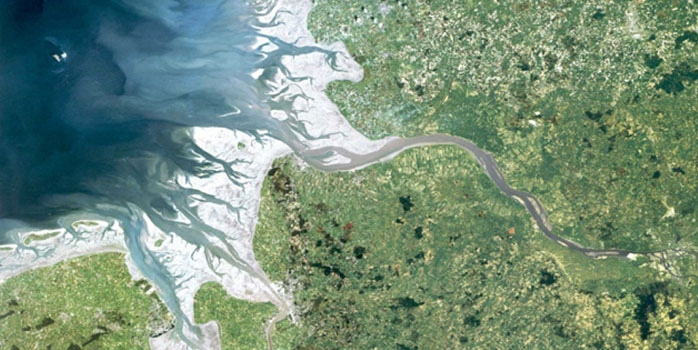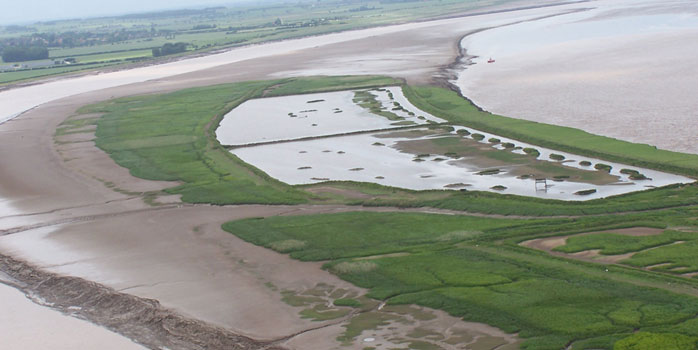

Disclaimer:
The authors are solely responsible for the content of this report. Material included herein does not represent the opinion of the European Community, and the European Community is not responsible for any use that might be made of it.
About TIDE toolbox
Estuarine management means a great challenge for the responsible authorities and demands extensive knowledge about very complex systems. The toolbox aims at supporting estuarine managers in their work and provides experience, recommendations and tools both for them and also the interested public.
Due to the complexity of their natural functioning and multiple anthropogenic uses, estuaries and their management face many challenges. The natural characteristics have to be protected and maintained while at the same time the use of estuaries and the present and future delivery of the ecosystem services and benefits required by society have to be safeguarded. Ideally successful and sustainable estuarine management should lead to ‘triple wins’ - for ecology, economy and society. The TIDE toolbox addresses the necessary ingredients for this management strategy – integrated estuarine management.
Studies resulting of the project and tools such as recommendations, decision support, methodologies and templates are in the toolbox. Firstly, it provides essential knowledge on estuarine functioning and the delivery of ecosystem services from which societal benefits can be derived. Following this, the existing management initiatives and plans within the four TIDE estuaries are made available after being subjected to a strengths, weaknesses, opportunities and threats (SWOT) analysis in order to present good/best practices. The toolbox allows managers to determine where the uses and users are and whether there are conflicts between these. This knowledge facilitates the implementation of appropriate management measures and restoration projects adequate to the problem. The toolbox allows the manager to search examples of success or failure as well as the costs of different actual or planned management measures related to different management topics as for example habitat restoration or sediment transport. In order to be successful, governance initiatives and measures have to be embedded in an appropriate communication and information programme, hence the toolbox presents the relevant experiences and lessons learned.
As the estuarine natural and social system is very complex, diverse aspects of each issue or research question have to be considered singly or better still in combination in order to achieve integrated estuarine management. The toolbox allows for this by presenting related links, for example one or more keywords or management issues which may guide the user to several reports, tools or links.
Estuarine management, its institutions and stakeholders cover a wide range of aspects and interests, have different levels of knowledge, and different ways of approaching a challenge and may be interested in one or more particular tools. Therefore the toolbox provides several ways to approach the diverse TIDE products. Users may locate a report for their specific interest by searching via a keyword or a management issue, or immediately go to a measure or the list of tools. Conversely, someone reading a summary may require to go deeper into one or more reports. It is possible to scroll down in a document and enlarge graphs and tables, but the products can also be downloaded as pdf documents.
A generic roadmap for integrated management including the instructions for performing an Environmental Impact Assessment, is embedded within and provides an Estuarine Planning Support System (EPSS). The overall summary report brings together all the different aspects as applied for the four TIDE estuaries.
The different TIDE products form the basis for the Ecosystem Approach which is considered an integral part of integrated estuarine management to achieve sustainable management. These aspects are separated in the toolbox according to the main chapters ´Functioning´, Governance´ and ´Measures´.
Consolidated knowledge of the (historical) development, dynamics and functioning of your estuary is a precondition for successful management and governance. Therefore, firstly the toolbox offers background information on estuarine structures and processes in the TIDE estuaries. While not all of this will be relevant when considering other estuaries, it does indicate the features to be considered.
A knowledge of the ecological and hydromorphological functioning of estuaries is central to the successful implementation of governance, which includes the policies, politics, administration and legislation spheres. This system must encompass the different estuary functions, stakeholder interests and societal benefits emanating from the ecosystem services. The national, European and international legislative framework has given rise to many types of existing estuarine management plans. As these are often sectoral approaches targeted at specific pressures various conflicts still occur in all estuaries. Therefore, an integrated management approach is the only solution for successfully managing estuaries aiming at preserving the natural functioning of the system, the maintenance of ecosystem services and the delivery of societal benefits. The successful implementation of management plans and measures requires a good communication strategy in order to reach public and stakeholders ´acceptance. The toolbox gives lessons which may be relevant to other estuaries.
During the last centuries all estuaries have faced varied minor and major changes and developments related both to natural events as well as the human requirements. This, together with the complicated governance framework, has resulted in a multisectoral, multiconflict, multiuse and multiuser system superimposed on the historical legacy of natural and anthropogenic change. This then requires that restoration measures should be carried out in order to preserve or improve the state of estuaries for the benefit of both nature and society. As an example of what is possible within estuaries, the success has been assessed of 42 measures related to different management purposes. Resulting from this analysis the toolbox presents the lessons learned and the best practices of the implementation of various measures.
The toolbox presents and gives guidance on the diverse tools such as:
- recommendations on how to carry out a zonation approach;
- guidance on how to conduct a monetary evaluation of ecosystem services;
- methods, e.g. for calculating residence times;
- the analysis of monitoring requirements
- recommendations on setting up an appropriate monitoring programme;
- an App for smartphones as a tool to avoid or reduce bird disturbance;
- an overview of the implementation of the most important national and EU legislation and the evaluation of existing management plans of the four estuaries;
- an example of a communication strategy;
- a study on public perception of residents along the Elbe estuary;
- an environmental impact assessment study evaluating the application of European legislation in different countries;
- an Estuarine Planning Support System (EPSS);
- best practices of implementing European legislation;
- a template for conducting an analysis on conflicting uses as well as synergies
- recommendations on how to set up a management measure;
- a catalogue of measures which are already carried out and/or planned for the next future and their evaluation;
- studies on several pilot projects and sediment management strategies;

Elbe and Weser estuary - satellite image; © Brockmann Consult, Common Wadden Sea Secretariat



